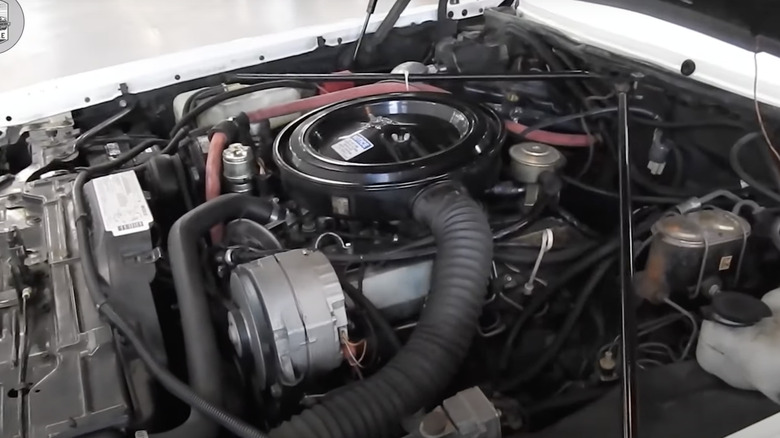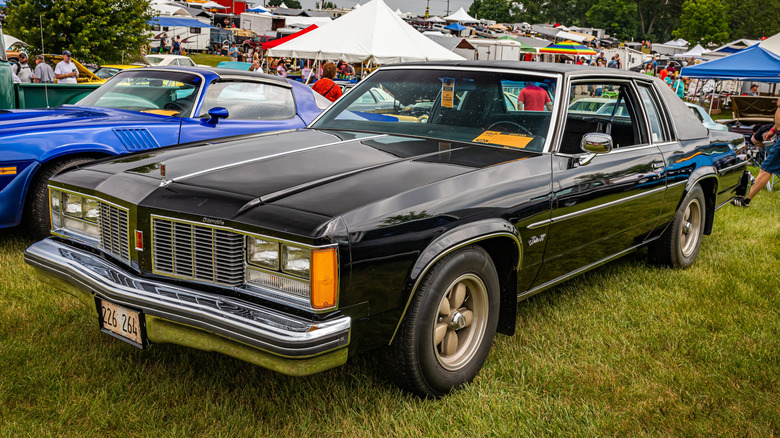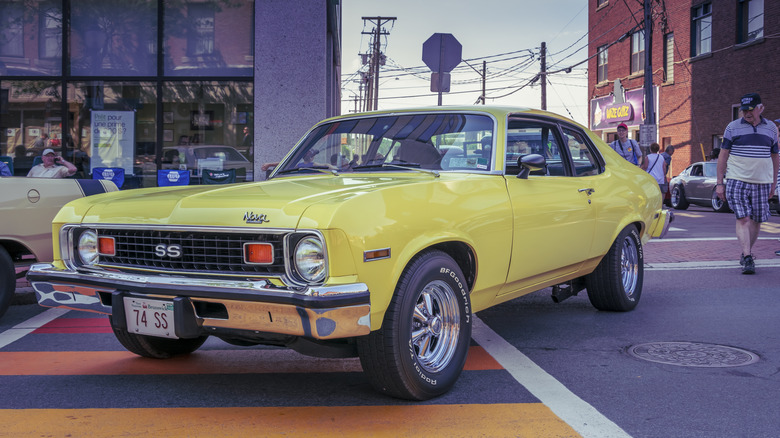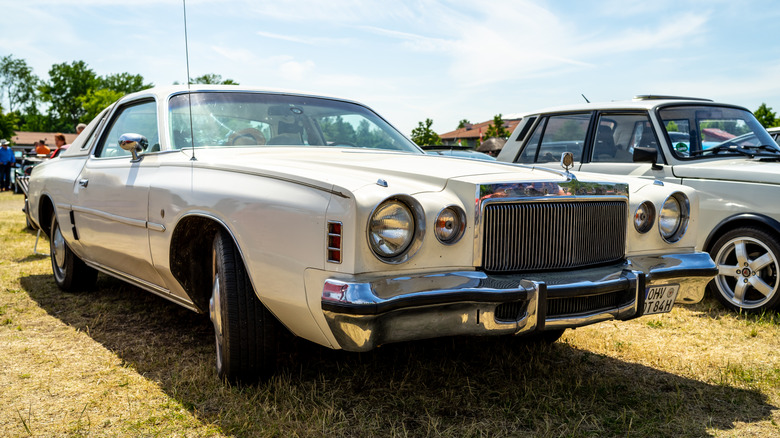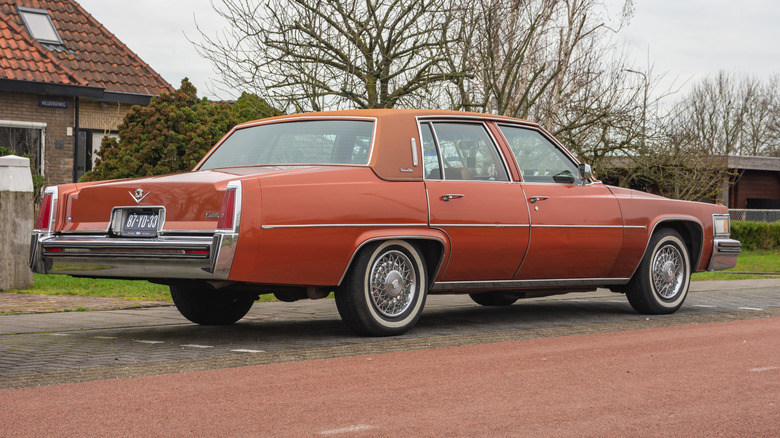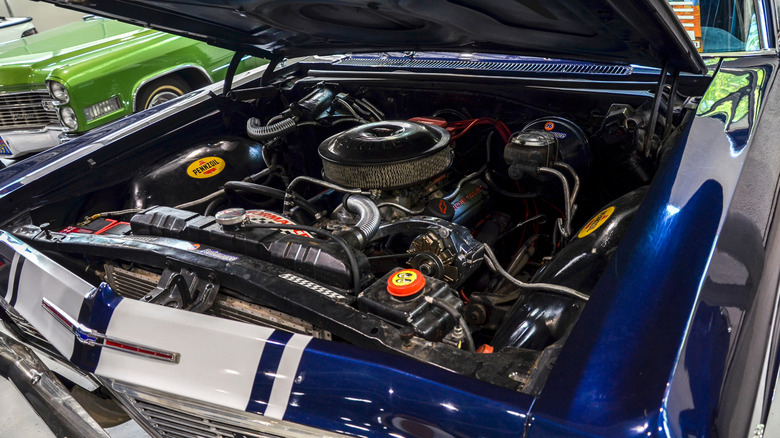5 American V8 Engines That Failed To Live Up To The Hype
The V8 engine is a legend in American motoring folklore. Just the mention of a V8-powered classic American muscle car can get the hairs on the back of any gearhead's neck to stand up. From the 1955 debut of the Chevy small-block V8 through the horsepower wars of the 1960s to today's 750-plus horsepower hypercar V8s, the format has a lot to shout about. Or perhaps "roar about" is more appropriate.
Despite its long association with American motoring, the V8 actually traces its roots back to France and an inventor named Leon Levavasseur. Initially, the V8 was intended for the fledgling aeronautical industry. However, early versions were underpowered for aircraft but found success in speedboat racing. Later iterations were more successful in planes, and are credited with powering the first flight to reach 3,600 feet in 1910. To help understand how radical an idea V8 architecture was, it's worth noting that in the early 1900's, three cylinders in an engine was considered advanced.
It didn't take long for American automakers to embrace the V8 format; Cadillac was the first such company to mass-produce a V8 engine in 1914. From these roots, the legendary American V8 was born, and it grew until new emissions and fuel economy standards all but killed the muscle car era in the early '70s. Although, as we will discover below, not every American V8 was a point of pride for the industry. Some were underpowered, some were unreliable, and others simply failed to live up to expectations.
Oldsmobile LF9 V8: A diesel-powered dud
the Oldsmobile LF9 diesel V8 was introduced in 1978 an attempt by General Motors to meet new environmental regulations and respond to the oil crisis of 1973. Many believe that the LF9 V8 was a re-engineered version of GM's gasoline-fueled 350-inch V8 small block, but this isn't correct. While it shared its displacement figure, a cylinder head bolt pattern, and some components with gasoline equivalents, the LF9's block was a beefed-up design unique to that motor. Sadly, that point does nothing to excuse just how bad this engine was. Initially, the outlook for the 5.7-liter LF9 was promising. It was introduced in the Delta 88 and 98 on September 13, 1977 and sold 60,000 units in its first year. Additional sales in Cadillac Sevilles and Chevy C-10 pickups took the total to 129,000 units, but this was the high point for the LF9.
One of its major issues was with the head gasket, which blew frequently thanks to head bolts that simply weren't up to the job. Other design flaws included the absence of a water separator. This allowed coolant to build up inside the fuel system and sometimes destroy the fuel injection pump. The performance of the engine wasn't anything to write home about, either. The first-generation version produced an unimpressive 120 horsepower, which was not great for a 5.7-liter V8. The LF9 helped scare American buyers away from diesel engines for decades — you could say it put the "die" in diesel.
Chevrolet 262 small block V8: Underpowered and underwhelming
Not every American V8 was destined for greatness, as the Chevrolet 262 cubic inch (4.3-liter) small block introduced in 1975 demonstrates. This engine came around at the worst time for V8s, as tighter emissions regulations and rising fuel prices were transforming the industry. This engine aimed to deliver improved efficiency while retaining traditional V8 power and appeal. Unfortunately, the reality didn't quite match expectations; the best that can be said is that it helped keep the V8 format on the market for a brief while.
This was the smallest and weakest first-generation Chevy small-block engine ever, with a displacement less than some of today's six-cylinder engines and an output of only 110 horsepower. Ultimately, it was this lack of power that sounded the death knell for the engine, and production was halted towards the end of 1976 after just a couple of years. In its short lifespan, the 262 found its way into three GM models: the Chevy Monza and Nova and the Pontiac Ventura. It was replaced by a 305-inch V8 in 1977.
Chrysler lean-burn V8: A different flawed approach
There is a distinct pattern emerging when looking at bad V8 engines: so far, they've all been designs that reflected the need for a more efficient and environmentally mindful engineering approach. While GM took the diesel route with the LF9 and the less-is-more approach with the 262, Chrysler opted for a big gasoline-powered V8 using what the company called "lean-burn" technology. What could possibly go wrong? Quite a lot, in fact. The engine made its debut in 1976 and featured an early computerized spark control system. This was the same year Steve Wozniak and Steve Jobs demonstrated the first Apple computer, so computerizing an engine was no small feat.
In some regards, the engine delivered on its promises, allowing Chrysler to meet emissions standards without using a catalytic converter. In tests carried out by Road and Track Magazine in 1976, a lean-burn V8 powered 400 Cordoba got 2.5 miles per gallon more than a V8 Hemi-powered Dodge Charger. However, Chrysler's decision to mount the computer on the air cleaner meant it was exposed to heat and vibration with the inevitable results. The lean-burn V8 certainly wasn't one of the most reliable GM engines, as it was plagued by plentiful vacuum leaks and sensor failures. Ultimately, more advanced electronic fuel injection and engine control systems did what Chrysler's lean-burn V8s couldn't.
Cadillac 8-6-4 L62: An identity crisis
When does a V8 become a V4? Answer: When it's a Cadillac 8-6-4 L62 engine. This was another attempt at improving the efficiency of V8 engines without compromising too much in the way of top-end performance. It was also another early example of computerized engine control. In this instance they didn't determine how much fuel the engine guzzled, but rather how many cylinders guzzled the fuel. When power demand was low, the computer activated solenoids on the rocker arms to disable either two or four cylinders. When more power was required, the computer re-activated all eight cylinders. It was a sound idea, but it wouldn't be on this list if it had been implemented properly.
The result was nothing short of disastrous; this was 1981 and it's another tale of computers being too primitive to perform the tasks being asked of them. The microprocessor — although capable of an estimated 300,000 decisions per second — just wasn't quick enough for the job. The result was an engine that lagged to the point where cars sometimes drove like they were searching for the correct gear. Despite 13 software updates in its first year, the problems were never resolved and the ultimate solution was to disable the system and keep the engine in a permanent V8 configuration. With the evolution of computer systems, cylinder deactivation is now widely used by GM and other automakers, proving that the Cadillac 8-6-4 was simply ahead of its time.
Cadillac HT4100 V8: More of a miss than a HiT
Poor Cadillac. On the heels of its 8-6-4 catastrophe it was desperate to woo the public again and restore its battered pride. The HT4100 V8 wasn't the engine to do it with, though. The HT in the name stood for High Technology, and the 4100 represented the engine's 4,100 cubic centimeter (4.1-liter) displacement. Featuring an aluminum block with an iron head and an advanced throttle body fuel injection system, it looked promising off the drawing board. However, this thin veneer was quickly shattered as drivers realized just how weak a V8 this actually was with 135 hp and 200 pound-feet of torque.
The weight-saving aluminum block became a problem, too. Head gasket issues were common with the engine, with the cast-iron head bolts having a tendency to tear the softer aluminum when the going got hot. And this was an engine prone to coolant leaks, so the going often got hot. This engine was also rushed to production in 1982 after a shortened development program, and became a symbol of how even the most prestigious automakers can stumble badly when ambition outpaces engineering.
